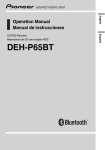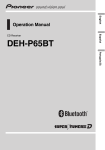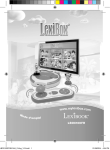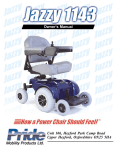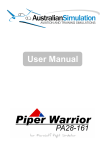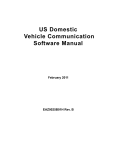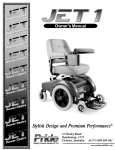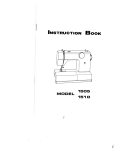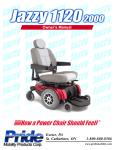Download Jazzy 1120 - Pride Mobility Products
Transcript
Owner’s Manual Unit 106, Heyford Park Camp Road Upper Heyford, Oxfordshire OX6 3HD www.pridemobility.com S A F E T Y G U I D E L I N E S Please read and follow all instructions in this owners manual before attempting to operate your Power Chair for the first time. If there is anything in this manual you do not understand, or if you require additional assistance for set-up, contact your local authorized Pride provider. Using your Pride product safely depends upon your diligence in following the warnings, cautions, and instructions in this owners manual. Using your Pride product safely also depends upon your own good judgement and/or common sense, as well as that of your provider, caregiver, and/or healthcare professional. Pride is not responsible for injuries and/or damage resulting from any persons failure to follow the warnings, cautions, and instructions in this owners manual. Pride is not responsible for injuries and/or damage resulting from any persons failure to exercise good judgement and/or common sense. The symbols below are used throughout this owners manual to identify warnings and cautions. It is very important for you to read and understand them completely. WARNING! Failure to heed the warnings in this owners manual may result in personal injury. CAUTION! Failure to heed the cautions in this owners manual may result in damage to your Power Chair. Copyright © 2002 Pride Mobility Products Ltd. 2 Jazzy 1120 CONTENTS I. INTRODUCTION ......................................................................................................................... 4 II. SAFETY ......................................................................................................................................... 6 III. THE JAZZY 1120 ..................................................................................................................... 8 IV. ASSEMBLY ................................................................................................................................. 13 V. COMFORT ADJUSTMENTS................................................................................................ 15 VI. DISASSEMBLY ......................................................................................................................... 20 VII. OPERATION ............................................................................................................................... 21 VIII. BATTERIES AND CHARGING ............................................................................................ 25 IX. CARE AND MAINTENANCE ................................................................................................ 29 X. OPTIONS AND ACCESSORIES ......................................................................................... 34 XI. WARRANTY ............................................................................................................................... 36 Jazzy 1120 3 I . I N T R O D U C T I O N Welcome to Pride Mobility Products, Ltd. (Pride). Congratulations on the purchase of your new Jazzy power chair. The Jazzy 1120 design combines the most advanced state-of-the-art components with modern, attractive styling. We are certain that the design features and trouble-free operation of your new Jazzy power chair will add convenience to your daily living. At Pride, your safety is important to us. Please read and follow all of the instructions in this manual before you attempt to operate your Jazzy for the first time. These instructions were produced for your benefit. Your understanding of these instructions is essential for the safe operation of your new Jazzy power chair. Pride is not liable for damage to property or personal injury arising out of unsafe use of a Jazzy power chair. Pride is also not liable for any property damage or personal injury arising out of the failure of any person and or/user to following the instructions and recommendations set forth in this manual or any other instructions or recommendations contained in other Jazzy related literature issued by Pride or contained on the Jazzy power chair itself. This owners manual is compiled from the latest specifications and product information available at the time of publication. We reserve the right to make changes as they become necessary. Any changes to our products may cause slight variations between the illustrations and explanations in this manual and the product you had purchased. If you experience any problems with your Jazzy that your are unable to solve, or if you do not feel capable of safely following any of the instructions and/or recommendations as contained in this manual, please contact your authorized Pride provider for assistance. Once you understand how to operate and take care of your Jazzy, we are certain that it will give you years of trouble-free service and enjoyment. Information Exchange We want to hear your questions, comments, and suggestions about this manual. We would also like to hear about the safety and reliability of your new Jazzy power chair, and about the service you received from your authorized Pride provider. Please notify us of any change of address, so we can keep you apprised of important information about safety, new products, and new options that can increase your ability to use and enjoy your Jazzy. Please feel free to write us at the address below: Pride Mobility Products, Ltd. Unit 106, Heyford Park Camp Road, Upper Heyford Oxfordshire, OX6 3HD 4 Jazzy 1120 I . I N T R O D U C T I O N My Authorized Pride Provider is: Name:_______________________________________________________________________________ Address:_____________________________________________________________________________ Phone Number:________________________________________________________________________ Quick Reference Information: Jazzy Model:__________________________________________________________________________ Serial Number:__________________________________________________________________________ Purchase Date:________________________________________________________________________ NOTE: If you ever lose or misplace your warranty card or your copy of this manual, call or write to us and we will be glad to send you a new one immediately. Jazzy 1120 5 I I . S A F E T Y Your Jazzy 1120 is a state-of-the-art, life-enhancement device designed to increase your mobility. There are certain situations, including some medical conditions, where you will need to practice operating your Jazzy 1120 in the presence of an attendant. Below are some safety tips that are designed to help you become accustomed to operating your new Jazzy safely. WARNING! Your Jazzy 1120 is a motorized vehicle. When you are seated in your Jazzy 1120 and you anticipate that you are going to be in a stationary position for an extended period of time, turn off the power. This eliminates the possibility of unexpected chair movement and conserves battery power. TRANSFERS Transferring onto and off of your Jazzy 1120 requires a good sense of balance. Be sure to have an attendant or health care professional present while learning to properly transfer yourself. To eliminate the possibility of injury, we ask that you verify the following before attempting a transfer: 1. Be sure the power is turned off. See VII. Operation. 2. Be sure your Jazzy 1120 is not in freewheel mode. See III. The Jazzy 1120. 3. Make sure the armrests are flipped up or removed from your Jazzy. 4. Flip the footrest up or move the leg rests aside; this helps to keep your feet from getting caught on the footrest or on the leg rests during the transfer. WARNING! Avoid putting all of your weight on the footrest. This may cause the Jazzy 1120 to tip and cause injury. MOTOR VEHICLE TRANSPORT Although your Jazzy may be equipped with a positioning belt, this belt was not designed with the intent of providing proper restraint during motor vehicle transport. n In an effort to improve the safety of its units during motor vehicle transport, Pride has crash tested numerous Jazzy models. However, since there are unlimited variations of the Jazzy product, all variations could not possibly be tested. Therefore, Pride recommends that Jazzy power chair users should not to be transported in vehicles of any kind while in power chairs. As of this date, there are no standards approved for tie-down systems in a moving vehicle of any type to transport a user while in a power chair. n Always be sure your Jazzy 1120 is properly secured when it is being transported. WEIGHT LIMITATIONS Your Jazzy 1120 is rated for a maximum 136-kg (21.6 stone) weight limit. WARNING! Exceeding the weight limit voids your warranty and may result in personal injury! STAIRS AND ESCALATORS WARNING! Power chairs are not designed to travel up or down stairs or escalators. Always use an elevator. If you try to negotiate steps or escalators, you can cause injury to yourself and to others! 6 Jazzy 1120 I I . S A F E T Y PUBLIC ROADS AND PARKING LOTS WARNING! Do not operate your Jazzy 1120 on public streets and roadways. Please be aware it may be difficult for traffic to see you when you are seated in your Jazzy. To ensure your safety, always assume you cannot be seen. Obey all authorized pedestrian traffic rules. Safety accessories like reflectors, fluorescent flags, and various lighting packages are available to order from your Pride provider. STEPS AND KERBS WARNING! Never attempt to have your Jazzy 1120 climb or descend a step or a kerb that is higher than 10 cm. Never attempt to have your Jazzy 1120 proceed backwards down any step, kerb, or other obstacle. Doing so could cause your Jazzy 1120 to tip. INCLINES AND UNEVEN TERRAIN When climbing an incline, try to keep your Jazzy moving. If you must stop, start up again slowly, and then accelerate cautiously. WARNING! When climbing an incline, do not zigzag or drive at an angle up the face of the incline. Always drive your Jazzy straight up the incline. This greatly reduces the possibility of a tip or a fall. Always exercise extreme caution when negotiating an incline. Never travel up or down an incline that can be potentially hazardous (for example, areas covered with snow, ice, or cut grass). When driving down an incline, do so slowly and in the forward direction only. If your Jazzy 1120 starts to move faster than you anticipated or desired it would, allow the chair to come to a complete stop by releasing the joystick. Push the joystick slightly forward and continue traveling slowly down the incline. MAXIMUM RECOMMENDED INCLINE Pride has performed extensive incline testing with the Jazzy 1120. Our results show that the maximum incline your Jazzy 1120 can safely climb is 8.7% at maximum weight capacity. The angle of most handicap access ramps is 8.7%. Any attempt to climb a steeper slope may put your Jazzy in an unstable position. Jazzy 1120 7 I I I . T H E JA Z Z Y 1 1 2 0 Your Jazzy 1120 has two main assemblies: the seat and the power base. See figure 1. There are a variety of seating options that are designed to accommodate most users. The seating assembly includes the armrests, seat back, seat base, and joystick/controller. Your Jazzy seat may also have some optional accessories attached to it, such as a basket, a cane/crutch holder, a cup holder, or a power seat switch. See X. Options and Accessories. The power base is the heart of your Jazzy 1120. The power base assembly includes two drive wheels, two anti-tip wheels, two rear caster wheels, a footrest, and a body shroud. See figure 1. SEAT BACK ARMRESTS JOYSTICK CONTROLLER SEAT ASSEMBLY SEAT BASE FREEWHEEL LEVER BODY SHROUD POWER BASE ASSEMBLY FOOTREST ANTI-TIP WHEELS REAR CASTER WHEEL DRIVE WHEEL Figure 1. The Jazzy 1120 8 Jazzy 1120 I I I . T H E JA Z Z Y 1 1 2 0 UTILITY TRAY Figure 2. The Jazzy 1120 Rear View REMOTE PLUS CONTROLLER HARNESS CONNECTOR BATTERY CHARGER POWER LEAD OUTLET AMMETER Figure 3. Utility Tray Jazzy 1120 9 I I I . T H E JA Z Z Y 1 1 2 0 UTILITY TRAY The utility tray is located on the rear of your Jazzy. See figure 2. A section of the utility tray is exposed through the body shroud. The rest of the utility tray is located underneath the rear door. The utility tray consists of the ammeter, the battery charger power lead, the main circuit breaker, the standard headlight/taillight connector, the full lighting harness connector (optional), and the Remote Plus controller harness connector. See figures 3 - 5. n Ammeter: The ammeter displays the chargers current output in amps. See figure 3. For more information, see VIII. Batteries and Charging. n Battery charger power lead: This lead is used whenever your battery needs recharging. See figure 3. n Main circuit breaker: The main circuit breaker is a safety feature built into your Jazzy 1120. See figure 4. When the batteries and the motors are heavily strained (e.g., from excessive loads), the main circuit breaker trips to prevent damage to the motors and the electronics. If the circuit trips, allow your Jazzy to rest for approximately one minute. Next, push in the circuit breaker button, turn on the joystick controller, and continue normal operation. If the main circuit breaker continues to trip repeatedly, contact your authorized Pride provider. n Remote Plus controller harness connector: This is where the joystick connects to the motors, batteries, and charger. See figure 3. n Full lighting harness connector: This 4-pin plug located in the rear utility tray is where the lighting harness connects to the controller. See figure 5. STANDARD HEADLIGHT/ TAILLIGHT CONNECTOR MAIN CIRCUIT BREAKER Figure 4. Main Circuit Breaker 10 FULL LIGHTING HARNESS CONNECTOR Figure 5. Full Lighting Harness Connector Jazzy 1120 I I I . T H E JA Z Z Y 1 1 2 0 FREEWHEEL LEVERS For your convenience, your Jazzy 1120 is equipped with two freewheel levers. See figures 6 and 7. These levers allow you to disengage the drive motors and maneuver the chair manually. WARNING! Do not use your Jazzy 1120 while the drive motors are disengaged unless you are in the presence of an attendant! Do not disengage the drive motors when your Jazzy 1120 is on an incline. The chair could roll down on its own, causing injury! To eng age or diseng age the fr ee wheel ffea ea tur e: enga disenga free eew eatur ture: 1. Turn the freewheel levers outward to disengage the drive motors. See figure 6. 2. Turn the freewheel levers inward to engage the drive motors. See figure 7. CAUTION! It is important to remember that when your Jazzy 1120 is in freewheel mode, the braking system is disengaged. If a lever is difficult to move in either direction, rock your Jazzy 1120 back and forth slightly. The lever should then move to the desired position. ACTIVE-TRAC SYSTEM Your Jazzy 1120 is equipped with an Active-Trac System (ATS). ATS is a suspension system designed to make your Jazzy traverse different types of terrain and obstacles while maintaining smooth operation. With ATS, your front anti-tip wheels work in conjunction with your motor suspension to help you maneuver over obstacles in excess of 8 cm in height. As your front anti-tip wheels come in contact with an obstacle, the front anti-tip wheel assembly is drawn upward. At the same time, your motors are forced downward. This reduces the possibility of your Jazzy 1120 becoming caught on the obstacle. ATS also helps in day-to-day operating conditions. For instance, when you release the joystick, your Jazzy begins to slow down. As the chair slows down, the front anti-tip wheels will automatically drop toward the ground. This will reduce the forward tip that is typically encountered with center-wheel drive chairs. FREEWHEEL LEVERS Figure 6. Drive Disengaged Jazzy 1120 FREEWHEEL LEVERS Figure 7. Drive Engaged 11 I I I . T H E JA Z Z Y 1 1 2 0 Specifications Suspension: Full suspension with Active-Trac System Drive Wheels: 36 cm, pneumatic (solid tyres are optional) Rear Casters: 20 cm, pneumatic, rear articulating Anti-Tip: 15 cm, solid, front mounted Maximum Speed: 6 km/hr Brakes: “Intelligent Braking,” electronic regenerative, disc park brake Ground Clearance: 9 cm Turning Radius: 50 cm Overall Size: Length: 100 cm Width: 65 cm Seating Options: Mid-back Seat High-back with headrest Reclining Seat Versa Seat Drive Train: Two motor, mid wheel Batteries: Two 12-volt, Group 24 batteries (NF-22 batteries for the power seat option) Range: Up to 40 km Battery Charger: Onboard Off-board (optional) Electronics: 70-amp Remote Plus Controller Weight Capacity: 136 kg/21.6 stone Jazzy Weights: Base: 37 kg Seat: 13 kg Batteries: 20 kg each Warranty: Lifetime limited warranty on frame Two-year warranty on electronics Eighteen-month warranty on drive motors 12 Power Elevating Option Recaro Seat (SE) Jazzy 1120 I V. ASSEMBLY SEAT INSTALLATION SLIDE SEAT ONTO REAR SEAT TOWERS (Seat with H-frame) The standard seat installation method incorporates the seat frame (H-frame) and four (4) adjustable seatposts located on the power base. To install the seat: 1. Set the seat on the rear seat towers. See figure 8. 2. Push the seat back and down until the latches engage on the front seat towers. See figure 9. Figure 8. Rear Seat Towers 3. Plug the controller cable into the connector on the utility tray. LOCK SEAT INTO PLACE HERE See figure 10. 4. Plug the power seat switch cable (if so equipped) into the connector on the utility tray. 5. Secure the controller cable to the armrest receiver with one or more wire ties. 6. Route the cable to ensure that the cable cannot be pinched in the seat hinge. (Seat with Euro H-frame) Figure 9. Front Seat Towers 1. Remove the shroud. PLUG IN CONTROLLER CABLE 2. Remove the seat tower pins. See figure 11. You may need to rotate the pins back and forth to remove them. 3. Insert the neoprene O-ring onto the seat tower receiver. See figure 12. 4. Insert the seat tower receiver into the frame. 5. Fasten the external snap-ring onto the end of the receiver so that it seats into the groove. You can use your fingers to pull the snap-ring into place. You may need to remove the front battery if you want to use external snap-ring pliers. 6. Replace the shroud. 7. Insert the seat towers into the seat tower receivers. Figure 10. Controller Cable SEAT TOWER PINS SEAT TOWER RECEIVER NEOPRENE O-RING EXTERNAL SNAP-RING Figure 11. Seat Tower Pins Jazzy 1120 Figure 12. Insert the Neoprene O-ring 13 I V. ASSEMBLY 8. Insert the joystick into the mounting bracket and adjust the length. 9. Tighten the joystick mounting setscrews. 10. Connect the joystick cable to the utility tray connection. 11. Use a zip tie to secure the joystick cable to the seat back. JOYSTICK INSTALLATION Depending on the various configurations and options you have chosen for your Jazzy, it may have been shipped without the joystick installed in the armrest. SLIDE JOYSTICK INTO BRACKET SETSCREW To 1. 2. install the jo ystic k: joystic ystick: Use a 3/16-in. hex key to loosen the setscrew. See figure 13. Slide the joystick mounting bracket into or out of the armrest to the desired position. 3. Retighten the setscrew. POWER SEAT OPTION INSTALLATION Your Jazzy may be equipped with the power seat option. While the seat itself may be any one of the styles offered for this model, the way the seat base attaches to the Jazzy power base is different. Figure 13. Joystick POWER SEAT ACTUATOR To install the power seat: 1. Align the seat shaft to the hole in the power seat actuator. See figure 14. 2. Rotate the seat to the forward position until it locks tightly. VERSA SEAT OR VERSA TILT OPTION If your Jazzy is equipped with a Versa Seat or Versa Tilt, please refer to the instruction manual supplied with the Versa Seat/Versa Tilt. Figure 14. Power Seat Actuator 14 Jazzy 1120 V. C O M F O R T A D J U S T M E N T S Once you are familiar with your Jazzys operation, you may find the need to adjust your seating position. There are some adjustments you can make to increase your comfort, such as seat height and angle, armrest width and angle, joystick position, and footrest height and angle. Required Tools: 7/16-in. wrench, 5/32-in. hex key CAUTION! If your Jazzy 1120 was configured at your authorized Pride provider, please consult your health care professional before changing the seat position or before making any other adjustment. Some adjustments may degrade your Jazzys performance and safety by changing its center of gravity. SEAT HEIGHT AND ANGLE You can change the seat height by one of two ways: manually or automatically. (If equipped with the optional Power Elevating Seat, see Power Elevating Seat Option later in this section.) To 1. 2. 3. 4. 5. 6. 7. BALL DETENT PIN change the seat height: Remove the seat. See VI. Disassembly. Remove the shroud. Remove the ball detent pin from each seat tower. See figure 15. Raise or lower each seat tower to the desired position. Install the ball detent pin into each seat tower. Reinstall the shroud. Install the seat. You can change the seat angle by either raising or lowering only one set of seat towers (front or rear). ARMREST WIDTH To change the armrest width: 1. Locate the two knobs on the armrest receiver bracket. See figure 16. 2. Loosen the knobs and slide the armrests in or out to the desired width. 3. Tighten the knobs. Figure 15. Seat Tower LOOSEN KNOBS TO MOVE ARMREST Figure 16. Armrest Width Jazzy 1120 15 V. C O M F O RT A D J U S T M E N T S ARMREST ANGLE You can adjust the armrest angle to fit your specific needs. TURN THIS SCREW TO CHANGE ARMREST ANGLE To 1. 2. 3. 4. change the armrest angle: Lift the armrest straight up so that it is perpendicular to the floor. Use a 7/16-in. wrench to loosen the locking nut. See figure 17. Use a 5/32-in. hex key to loosen the adjustment screw. Turn the screw clockwise to lower the front of the armrest, or turn the screw counterclockwise to raise the front of the armrest. 5. Lock the adjustment screw into place by tightening the locking nut. ARMREST HEIGHT Your Jazzy is equipped with height-adjustable armrests. LOCKING NUT LOCKS ADJUSTMENT SCREW IN PLACE Figure 17. Armrest Angle Adjustment To change the armrest height: 1. Loosen the setscrew located underneath the armrest using a 3/16-in. hex key. 2. Remove the ball detent pin from the armrest. 3. Move the armrest up or down to the desired height. 4. Align the holes and reinsert the ball detent pin. 5. Retighten the setscrew. LOOSEN THIS SETSCREW TO ADJUST JOYSTICK JOYSTICK EXTENSION The joystick control can easily slide out away from the armrest, or in toward the armrest. To extend the joystick: 1. Use a 3/16-in. hex key to loosen the setscrew. See figure 18. 2. Slide the joystick mounting bracket into or out of the armrest to the desired position. 3. Re-tighten the setscrew. Figure 18. Joystick Extension SWING-AWAY JOYSTICK Your Jazzy may be equipped with a swing-away joystick. This option enables you to move the joystick from the front of the armrest to the side of the armrest, without disconnecting it. The joystick can be mounted to the left or right side of your Jazzy. Contact your authorized Pride provider if you have any questions. 16 Jazzy 1120 V. C O M F O R T A D J U S T M E N T S FOOTREST HEIGHT The footrest height is easily adjusted to one of six different heights in 3 cm increments. REMOVE THESE NUTS AND BOLTS TO RAISE OR LOWER THE FOOTREST To raise or lower the footrest: 1. Remove the two 7/16-in. bolts and their nuts from the footrest. See figure 19. 2. Raise or lower the footrest to the desired height. 3. Install the two 7/16-in. bolts and nuts into the footrest and tighten. FOOTREST ANGLE You can adjust the angle of the footrest with a 3/16-in. hex key. See figure 20. To adjust the footrest angle: 1. Turn the setscrew clockwise to raise the front of the footrest. 2. Turn the setscrew counterclockwise to lower the front of the footrest. Figure 19. Footrest Height TURN SETSCREW TO CHANGE FOOTREST ANGLE SWING-AWAY FOOTRESTS OPTION Swing-away footrests (SFRs) are an option. They enable you to swing the footrest to the side before transferring from your Jazzy. To swing the footrest: 1. Push in the SFR release lever. See figure 21. 2. Swing the footrest off to the side. Figure 20. Footrest Angle SFR RELEASE LEVER Figure 21. Swing-away Footrests Jazzy 1120 17 V. C O M F O RT A D J U S T M E N T S ELEVATING LEG RESTS OPTION Elevating Leg Rests (ELRs) offer an infinite range of adjustment between 0 and 70 degrees for the leg angle and a footrest adjustment range of 38 50 cm. ELR RELEASE LEVER To adjust the ELR angle: 1. Press the ELR release lever. See figure 22. 2. Move the leg rest to the desired angle. To adjust the ELR footrest height: 1. Remove the two leg rest adjustment screws from the side of each leg rest extension. See figure 23. 2. Loosen the leg rest adjustment bolt on the side of each leg rest extension. 3. Slide the leg rest in or out to the desired length. 4. Tighten the leg rest adjustment bolt and reinstall the two leg rest adjustment screws on each leg rest extension. Figure 22. Elevating Leg Rests LEG REST ADJUSTMENT BOLT LEG REST ADJUSTMENT SCREWS RECLINING SEAT OPTION If your Jazzy is equipped with a reclining seat, you can adjust the seat back angle and the armrest angle. To adjust the seat back angle: 1. Press down on the seat back release lever. See figure 24. 2. Move the seat back down or up to the desired position. 3 Release the seat back release lever. Figure 23. Elevating Leg Rests SEAT BACK RELEASE LEVER Figure 24. Seat back Release Lever 18 Jazzy 1120 V. C O M F O R T A D J U S T M E N T S POWER ELEVATING SEAT OPTION If your Jazzy is equipped with a power elevating seat, you can change the seat height automatically. The power seat switch is located on the armrest. See figure 25. POWER SEAT SWITCH To change the seat height: 1. Push forward on the power seat switch to raise the seat. 2. Pull back on the power seat switch to lower the seat. POWER SEAT CAUTIONS Read your Jazzy 1120 Owners Manual thoroughly before operating your Jazzy. Figure 25. Power Seat WARNING! The power seat option is intended for use while your Jazzy is on level surfaces only. Always fasten the safety belt when operating the power elevating seat. The power elevating seat option is equipped with a system that reduces your Jazzys speed by one half when the seat is elevated more than 35 cm. Always check to be sure this system is operating properly before using your Jazzy. Never raise the seat from its lowest position on an inclined surface, or while on bumpy or uneven surfaces. Failure to heed this warning can result in your Jazzy tipping over and causing injury. Operate your Jazzy only on a flat level surface whenever the elevating seat is raised from its lowest position. Never raise the power elevating seat when the chair is in freewheel mode. HIGH-BACK WITH HEADREST OPTION If your Jazzy is equipped with the deluxe high-back seat, you can adjust the headrest height. To adjust the headrest height: 1. Push in the headrest release button. 2. Move the headrest up or down to the desired position. Jazzy 1120 19 V I . D I S A S S E M B LY SEAT REMOVAL You may wish to remove the seat for transportation. If you have a Versa Seat, please refer to the Versa Seat Installation and Adjustment guide. To 1. 2. 3. 4. remove the seat: Turn the power off. Make sure your Jazzy is not in freewheel mode. Unplug the main wire harness behind the seat. Simultaneously depress the two plungers on the front of the seat frame while lifting the front of the seat. See figure 26. 5. Lift the seat up and gently lower it back onto the front seat towers. 6. Pull the seat forward and lift it off of the rear seat towers. To remove a power seat: 1. Push down on the seat release lever. 2. Lift the seat off of the power seat actuator. Figure 26. Removing The Seat BODY SHROUD REMOVAL The body shroud is a one-piece, molded plastic body that covers the power base frame. It helps protect the Jazzy components from the environment. It also provides mounting points for lights and the standard light switch. You must remove the body shroud in order to change the batteries and check the cable connections. To 1. 2. 3. 4. 5. 6. remove the body shroud: Turn the power off. Make sure your Jazzy is not in freewheel mode. See III. The Jazzy 1120. Unplug the controller wiring harness. Remove the seat. Disconnect the lighting harness (if your Jazzy is equipped with lights). Lift the body shroud straight up. The body shroud is attached to the metal frame by reusable fasteners. The body shroud should lift up easily. WARNING! Your Jazzy 1120 batteries weigh approximately 20 kg each. Lifting weight above your capability could result in injury! BATTERY REMOVAL To remove the batteries: 1. Turn the power off. 2. Remove the body shroud. 3. Remove the battery post caps (both red and black). 4. Unscrew the wing nuts on (+) red battery terminals, one at a time. 5. Remove the (+) red battery cables from the battery posts; be sure to secure the terminals away from the batteries. 6. Loosen the wing nuts on (-) black battery terminals. 7. Remove the (-) black cables and secure the terminals away from the batteries. 8. You can now remove the batteries from your Jazzy 1120. 20 Jazzy 1120 V I I . O P E R AT I O N JOYSTICK AND CONTROLLER Your Jazzy is operated by your joystick and controller. The Jazzy 1120 is currently available with the Remote Plus Remote. See figure 27. Figure 27. Remote Plus Controller To operate your Jazzy: 1. Turn the power on (push the on/off key). The battery condition meter lights, indicating the present charge of your battery. 2. Push the joystick in the direction you wish to move. The further you push the joystick from the neutral (center) position, the faster your Jazzy 1120 moves. CONTROLLER FUNCTIONS The controller translates the speed and the directional information from the joystick for the motors. It has selfdiagnostic features that are designed to search for potential problems at the rate of 100 times per second. If the controller detects a problem in the power chairs electrical system, the power chair may, depending on the severity of the problem, stop functioning (see Trouble Codes). The controller is designed to maximize user safety under normal operating conditions. This controller, however, cannot take into account circumstances that put your Jazzy 1120 outside of its normal operating environment as described within this manual. It is very important that you follow the precautions described within this manual. Jazzy 1120 21 V I I . O P E R AT I O N REMOTE PLUS CONTROLLER The Remote Plus controller system consists of the joystick (see figure 28) and the controller box. The joystick sends signals to the controller box through a cable attached to the back of the joystick. This cable connects to the controller box through the utility tray. The Remote Plus joystick is typically located at the end of either the right or the left armrest. The Remote Plus controller box is located underneath the front of the power base. Joystick Functions The joystick function is similar for all controller configurations. The joystick controls the direction and speed of the power chair. See figure 29. When you move the joystick from the neutral (center) position, the electromagnetic brakes release and allow the power chair to move. The further you push the joystick from its neutral position, the faster your Jazzy moves. When you release the joystick and allow it to return to the neutral position, you engage the electromagnetic brakes. This causes the chair to decelerate and come to a complete stop. If your Jazzy 1120 begins to move in an unexpected manner, immediately release the joystick. Unless the joystick is damaged, this action should stop your Jazzy 1120. ON/OFF KEY MODE KEY BATTERY CONDITION METER HORN KEY SPEED INDICATOR Figure 28. Remote Plus Joystick Features WARNING! Do not use the on/off key to stop the chair. This may cause injury. Battery Condition Meter The battery condition meter consists of ten LEDs over the speed indicator. These lights are an accurate indication of your usable battery capacity. They also alert you of any faults found within your unit. See Trouble Codes. On/Off Key The on/off key turns your unit on and off. Figure 29. Joystick Movement HAZARD WARNING LIGHT SWITCH Horn Key This key activates the horn. TURN SIGNALS Figure 30. Remote Plus Optional Features 22 Jazzy 1120 V I I . O P E R AT I O N Speed and Actuator Adjustments The Remote Plus joystick controller is equipped with a mode key and a speed indicator. See figure 39. The mode key allows you to access different power chair functions. Activating the mode key allows you to adjust the maximum power chair speed. To increase or decrease the overall speed, activate the mode key once. Pushing the joystick to the right will increase the speed setting. Pushing the joystick to the left will decrease the speed setting. The speed indicator LEDs will light up from left to right. When one LED is lit, the speed is in the slowest setting. When all five LEDs are lit, the speed is in the fastest setting. After selecting your desired speed, activate the mode key again to return to drive or simply activate the joystick in the forward or reverse direction and your Jazzy will operate at the selected speed setting. NOTE: We recommend that the first few times you operate your Jazzy 1120 you have your speed adjustment mode on the slowest setting until you to become familiar with your new power chair. If your Jazzy is equipped with power seat functions, you can access seat control by pressing the mode key twice. Push the joystick to the right to toggle to your desired seat function. The LED will light in various positions indicating which seat function is active. When the LED is lit in the appropriate section, push the joystick forward to raise the actuator and push the joystick in reverse to lower the actuator. To return to drive, activate the mode key again. SLEEP MODE If your Jazzy 1120 is equipped with a Remote Plus controller, then you have a sleep mode feature. Sleep mode is a built-in circuit that automatically shuts off the main power if the joystick is not moved in any direction for approximately five minutes. The battery condition meter lights on the joystick indicate sleep mode by blinking once every five seconds. To restore power and continue, push the on/off key twice. THERMAL ROLLBACK Jazzy 1120 controllers are equipped with a thermal rollback circuit. This circuit monitors the temperature of the motors and the controller. In the event that the motors or the controller become excessively hot (above 50° C/122° F), the controller reduces the motor voltage. For every degree above 50° C/122° F, the controller reduces the voltage by 5 volts. This reduces your Jazzys speed and allows the electrical components to cool down. When the temperature returns to a safe level, your Jazzy 1120 resumes its normal speed. Jazzy 1120 23 V I I . O P E R AT I O N TROUBLE CODES In addition to indicating the current state of battery charge, the battery condition meter can also indicate possible problems with your Jazzy 1120. The battery condition meter has ten individual bars. The bars provide information by the number of bars that are flashing. If the meter is flashing rapidly, the controller may be indicating a fault. For instance, the very first red bar flashing rapidly indicates the battery voltage is nearly depleted. The following is a list of the possible errors signified by the rapidly flashing meter lights. Flashing Bars Diagnosis Solution 10 Green 9 Green 8 Green 7 Yellow 6 Yellow 5 Yellow 4 Yellow 3 Red 2 Red 1 Red High Battery Voltage Solenoid Brake Fault Possible Controller Fault Possible Joystick Fault Inhibit Active Right Motor Wiring Fault Right Motor Disconnected Left Motor Wiring Fault Left Motor Disconnected Low Battery Voltage Check Batteries Check Motor/Brake Wiring See Authorized Pride Provider See Authorized Pride Provider Unplug Charger/Check Connections Check Right Motor Wiring Check Right Motor Wiring Check Left Motor Wiring Check Left Motor Wiring Check Batteries/Battery Wiring If you cannot resolve your problem, see your authorized Pride provider. REMOTE PLUS OPTIONAL FEATURES See figure 41 to reference the following optional features: n Light switch: If your Jazzy is equipped with the deluxe lighting package, there is a light switch located on the joystick controller. When your Jazzy is powered on, the light switch activates the lights. n Turn signals: The arrow keys activate the turn signals regardless of whether or not your Jazzy is powered off or on. n Hazard warning: This key operates the hazard lights. n Power elevating seat up/down (not shown): These keys eliminate the need for an additional power elevating seat switch. 24 Jazzy 1120 V I I I . BAT T E R I E S A N D C H A RG I N G BATTERIES Your Jazzy 1120 uses two long-lasting, 12-volt, deep-cycle batteries. These batteries are sealed and maintenance free. Since they are sealed, there is no need to check the electrolyte (fluid) level. Deep-cycle batteries are designed to handle a longer and deeper discharge. Though they are similar in appearance to automotive batteries, they are not interchangeable. Automotive batteries are not designed to handle a long, deep discharge, and also are unsafe for use in power chairs. WARNING! Battery posts, terminals, and related accessories contain lead and lead compounds. Wash hands after handling. CHARGING THE BATTERIES The battery charger is essential in providing long life for your Jazzy 1120 batteries. See figure 31. The battery charger is designed to optimize your Jazzy 1120s performance by charging the batteries safely, quickly, and easily. The charging system consists of the battery charger, the fuse, and the ammeter. See figures 31 and 32. The (onboard) battery charger is located underneath the utility tray. The ammeter is located on the utility tray for easy viewing. The charger has an in-line fuse that protects the ammeter. The ammeter indicates the rate of charge necessary to fully recharge the batteries. It is also a good indication of whether or not the charger is working. The ammeter and the charger are only functional when the charger power lead is plugged into a wall outlet. NOTE: To ensure prolonged life, recharge your Jazzy 1120s batteries with the supplied onboard or the supplied off-board charging system. Do not use an automotive-type battery charger. BATTERY CHARGER FUSE WARNING! Never use an extension cord to plug in your battery charger. Plug the charger directly into a properly wired standard wall outlet. To charge the batteries using the onboard charger: 1. Position the rear of your Jazzy 1120 close to a standard wall outlet. 2. Be certain the controller power is turned off and the freewheel levers are in the engaged position. See III. The Jazzy 1120. 3. Remove the rear cover. 4. Extend the charger power lead and plug it into the wall outlet. The Jazzy 1120 incorporates an inhibit function that disables the power chair when the charger is plugged into a wall outlet. 5. The ammeter indicates how much charge is needed to fully charge the batteries. Wait about a minute for the charger to warm up. The ammeter may move as high as 5.5 amps, then gradually move back down to 0 amps as the batteries charge. 6. We recommend you charge the batteries for 8 to 14 hours. As the batteries charge, the ammeter needle slowly drops to zero. When the batteries are fully charged, the needle vibrates on or near the zero mark on the ammeter scale. Figure 31. Battery Charger AMMETER Figure 32. Utility Tray Jazzy 1120 25 V I I I . BAT T E R I E S A N D C H A RG I N G 7. When your Jazzy 1120s batteries are fully charged, you can unplug the power lead from the wall outlet, wind it up using the hook and loop strap, and place the lead back into the electronics module. 8. Replace the rear cover. OFF-BOARD CHARGER If your Jazzy is equipped with an off-board charger, follow these instructions: 1. Position your Jazzy next to a standard wall outlet. 2. Be certain the controller power is turned off. 3. Remove the run plug located on the utility tray. This activates the inhibit function. 4. Plug the 3-pin extension cable into the charger, then into the utility tray connector. 5. Plug the charger into the wall outlet. 6. The ammeter indicates how much charge is needed to fully charge the batteries. Wait about a minute for the charger to warm up. The ammeter should move all the way up to 5 amps, then gradually move back down to 0 amps. 7. We recommend you charge the batteries for 8 to 14 hours. As the batteries charge, the ammeter needle slowly drops to zero. When the batteries are fully charged, the needle vibrates on or near zero on the ammeter scale. 8. When your Jazzy 1120s batteries are fully charged, disconnect the charger lead from the wall outlet. 9. Disconnect the charger from the rear utility tray. 10. Reconnect the run plug into its connector. NOTE: If the run plug is not reconnected, your Jazzy will not run. 11. Replace the rear cover. BATTERY BREAK-IN To break in new batteries for maximum efficiency: 1. Fully recharge any new battery prior to its initial use. This brings the battery up to about 90% of its peak performance level. 2. Operate your Jazzy 1120 about the house and grounds. Move slowly at first, and dont stray too far until you become accustomed to the controls and break in the batteries. 3. Give the batteries another full charge of 8 to 14 hours and operate your Jazzy 1120 again. The batteries should now perform at over 90% of their potential. 4. After four or five charging cycles, the batteries top off at 100% charge and last for an extended period. BATTERIES AND CHARGINGFREQUENTLY ASKED QUESTIONS (FAQS) How does the charger work? The battery charger takes the standard wall outlet voltage and converts it to 24 VDC (direct current). The Jazzy 1120 batteries use direct current to run your power chair. When the battery voltage is low, the charger works harder to charge the battery. This is why the charging ammeter initially reads 5 or more amps. As the battery voltage approaches full charge, the charger doesnt work as hard to complete the charging cycle. This explains why the charging ammeter drops as it approaches a full charge. When the battery is fully charged, the amperage from the charger is nearly at zero. This is how the charger maintains a charge but does not overcharge the battery. 26 Jazzy 1120 V I I I . BAT T E R I E S A N D C H A RG I N G Can I use a different battery charger? You should use the charger supplied with the Jazzy 1120. It is the safest, most efficient tool to charge the batteries. We do not recommend using other types of chargers (e.g., an automotive battery charger). Your Jazzy 1120s charger will not operate after the batteries have been discharged to nearly zero voltage. If this happens, call your authorized Pride provider for assistance. How often must I charge the batteries? Many factors come into play when deciding how often to charge the batteries. You may use your Jazzy 1120 all day on a daily basis or you may not use it for weeks at a time. n Daily Use If you use your Jazzy 1120 on a daily basis, charge the batteries as soon as you are finished. Your Jazzy 1120 will be ready each morning to give you a full days service. It is recommended that you charge the batteries 8 to 14 hours after daily use. Do not charge the batteries for more than 24 hours at a charging cycle. n Infrequent Use If you use your Jazzy 1120 infrequently (once a week or less), you should charge the batteries at least once per week for 12 to 14 hours. NOTE: Keep your batteries fully charged and avoid deeply discharging your batteries. Do not charge the batteries for more than 24 hours at a charging cycle. How can I get maximum range or distance per charge? Rarely do you have an ideal driving situation such as smooth, flat, hard terrain with no wind, hills, or curves. More often you are presented with hills, pavement cracks, uneven and loosely packed surfaces, curves, and wind. All of these factors affect the distance or running time per battery charge. The following are a few suggestions for obtaining the maximum range per charge. n Always fully charge the batteries prior to your trip. n Maintain 3035 psi in pneumatic drive wheels. n Plan your trip in advance to avoid inclines if possible. n Limit baggage weight to essential items. n Try to maintain an even speed and avoid stop-and-go driving. Battery Specifications Type: Deep-cycle sealed lead-acid Size: Group 24 Voltage: 12 volts each Amperage: 70 - 80 amp hours Battery Specifications (power seat option only) Type: Deep-cycle sealed lead-acid Size: NF-22 (power seat option only) Voltage: 12 volts each Amperage: 45 - 55 amp hours Jazzy 1120 27 V I I I . BAT T E R I E S A N D C H A RG I N G What type of battery should I use? We recommend deep-cycle batteries that are sealed and maintenance free. Both sealed-lead acid (SLA) and gel cell are deep-cycle batteries that are similar in performance. Use these specifications to reorder deep-cycle batteries: Why do my new batteries seem weak? Deep-cycle batteries employ a much different chemical technology than that used in car batteries, nickel-cadmium (nicads), or in other common battery types. Deep-cycle batteries are specifically designed to provide power, drain down their charge, and then accept a relatively quick recharge. Lead acid batteries should be charged as often as possible. They do not have a memory like nickel-cadmium batteries. We work closely with our battery manufacturer to provide a battery that best suits your Jazzy 1120s specific demands. Fresh batteries arrive regularly at Pride and are promptly shipped with a full charge. During shipping, the batteries encounter temperature extremes that may influence initial performance. Heat robs the charge from the battery, and cold slows the power available and extends the time needed to recharge the battery (just as with a car battery). It might take a few days for the temperature of the battery to stabilize and adjust to its new ambient temperature. More importantly, it takes a few charging cycles (a partial drainthen a full recharge) to establish the critical chemical balance that is essential to the batterys peak performance and long life. It is well worth it to take the time to break in your battery properly. NOTE: The useful life of a battery is quite often a reflection of the care it receives. How can I ensure maximum battery life? A fully charged deep-cycle battery provides reliable performance and extended battery life. Keep your Jazzys batteries fully charged whenever possible. Batteries that are regularly and deeply discharged, infrequently charged, or stored without a full charge may be permanently damaged, causing unreliable Jazzy operation and limited battery life. How should I store my Jazzy 1120 and its batteries? If you do not use your Jazzy 1120 regularly, we recommend maintaining battery vitality by charging the batteries at least once a week. If you do not plan on using your Jazzy 1120 for an extended period, fully charge the batteries prior to storage. Disconnect the battery harnesses and store the Jazzy in a warm, dry environment. Avoid temperature extremes, such as freezing and excessively hot conditions, and never attempt to charge a frozen battery. A cold or frozen battery should be warmed for several days prior to recharging. NOTE: If you are storing a Jazzy 1120 for an extended period of time, you may wish to block the unit up with several boards under the frame. This keeps the tyres off the ground and prevents the possibility of flat spots from developing on them. WARNING! Battery posts, terminals, and related accessories contain lead and lead compounds. Wash hands after handling. 28 Jazzy 1120 I X . C A R E A N D M A I N T E N A N C E ROUTINE MAINTENANCE Your Jazzy is a sophisticated power chair. Like any motorized vehicle, it requires routine maintenance checks. You can perform some of these checks, but others require assistance from your authorized Pride provider. Preventive maintenance is very important. If you follow the maintenance checks in this section as scheduled, you can help ensure that your Jazzy gives you years of trouble-free operation. If you have any doubt as to your Jazzys care or operation, contact your authorized Pride provider. Your Jazzy 1120, like most electrical equipment, is susceptible to damage from the elements. Avoid damp areas of any kind. Direct exposure to water or dampness could cause the power chair to malfunction electronically and mechanically. Water can cause electrical components to corrode and the chairs frame to rust. Should your Jazzy 1120 come in contact with water: 1. Dry your Jazzy 1120 as thoroughly as possible with a dry towel. 2. Allow your Jazzy 1120 to sit in a warm, dry place for 12 hours to allow unseen water to evaporate. 3. Check the joystick operation and the brakes before using your Jazzy again. 4. If any inconsistencies are found, take your Jazzy 1120 to your authorized Pride provider. TEMPERATURE Some of the parts of your Jazzy 1120 are susceptible to extreme changes in temperature. Always keep your Jazzy 1120 between the temperatures of -8° C/18° F and 50° C/122° F. n In extremely cold temperatures the batteries may freeze. The specific temperature at which they freeze depends on a number of factors, such as battery charge, usage, and composition of the batteries (e.g., sealed lead-acid or gel cell). n Temperatures above 50° C/122° F may cause your Jazzy 1120 to operate at a reduced speed. This reduced speed is a safety feature built into the controller that helps prevent damage to the motor and other electrical components. See VII. Operation. GENERAL GUIDELINES n Avoid knocking or bumping the controller, especially the joystick. n Avoid prolonged exposure of your Jazzy to extreme conditions, such as heat, cold, or moisture. n Keep the controller clean. n Check all controller connectors on the utility tray to ensure that they are all tight and secured properly. Also check the charger harness connector. n When the battery indicator gauge is completely lit, the batteries are fully charged, and the controller and the electrical system are OK. n If one red bar on the battery indicator gauge is blinking slowly, the batteries are low and need to be charged, but the controller and the electrical system are OK. n If the battery indicator gauge is blinking rapidly, the controller Figure 33. Check Tyre Pressure has detected a fault in either its own circuits or in your Jazzys circuits. See VII. Operation. n Make sure the drive tyres are inflated to 30 35 psi. See figure 33. n Use a rubber conditioner on the tyre sidewalls to help preserve them. Never use a rubber conditioner on the tread area of the tyres; doing so may make the tyres slippery and cause your Jazzy to skid. Check for wear. Jazzy 1120 29 I X . C A R E A N D M A I N T E N A N C E n The body shroud has been sprayed with a clear sealant coating. You can apply a light coat of car wax to help it retain its high-gloss appearance. n Check all electrical connections. Make sure they are tight and are not corroded. Batteries must sit flat within the battery well, with the battery terminals facing inward, toward each other. Refer to the frame decal for the correct wiring layout. n All wheel bearings are prelubricated and sealed. They require no subsequent lubrication. DAILY CHECKS n With the controller turned off, check the joystick. Make sure it is not bent or damaged and that it returns to the center when you release it. Check the rubber boot around the base of the joystick for damage. Visually inspect the boot. Do not handle or try to repair it. See your authorized Pride provider if there is a problem. n Visually inspect the controller harnesses. Make sure that they are not frayed or cut or have any wires exposed. See your authorized Pride provider if there is a problem with any of these harnesses. WEEKLY CHECKS n Disconnect and inspect the controller and the charger harnesses from the utility tray. Look for corrosion. Contact your authorized Pride provider if necessary. n Ensure that all parts of the controller system are securely fastened to your Jazzy. Do not overtighten any screws. n Check for proper tyre inflation. There should be 30 35 psi in each tyre. If a tyre does not hold air, see your authorized Pride provider for replacement of the tube. n Check the brakes. This test should be carried out on a level surface with at least 1 meter of clearance around your Jazzy. To 1. 2. 3. check the brakes: Turn on the controller and reduce the speed by selecting 1 on the drive mode select key. After one second, check the battery gauge. Make sure that it remains on. Slowly push the joystick forward until you hear the electric brakes click. Immediately release the joystick. You must be able to hear each electrical brake operating within a few seconds of joystick movement. Repeat this test three times, pushing the joystick backwards, then left, and then right. 30 Jazzy 1120 I X . C A R E A N D M A I N T E N A N C E MONTHLY CHECKS n Check that the anti-tip wheels do not rub the ground when you are operate the Jazzy. Adjust them as necessary. See V. Comfort Adjustments. n Check for extreme wear on the anti-tip wheels. Replace them as necessary. n Check for drive tyre wear. See your authorized Pride provider for repair. n Check the rear casters for wear. Replace them as necessary. n Check the rear forks for damage or fluttering which indicates that they may need to be adjusted or have the bearings replaced. See your authorized Pride provider for repair. n Keep your Jazzy clean and free of foreign material, such as mud, dirt, hair, food, drink, etc. YEARLY CHECKS Take your Jazzy to your authorized Pride provider for yearly maintenance. This helps ensure that your Jazzy is functioning properly and helps prevent future complications. STORAGE If you fail to store your power chair in a dry place free from temperature extremes, the frame can rust and the electronics can be damaged. When storing, disconnect the batteries from the Jazzy. See VIII. Batteries and Charging. CLEANING INSTRUCTIONS n Never hose off your Jazzy 1120 or place it in direct contact with water. n Your Jazzy 1120 has a clear-coated, ABS plastic body shroud that allows it to be easily wiped clean with a damp cloth. Never use any chemicals to clean a vinyl seat, as they may cause the seat to become slippery or dry out and crack. Use soapy water and dry the seat thoroughly. TYRES AND TUBES If your Jazzy 1120 is equipped with pneumatic tyres, you should check the air pressure at least once a week. This prolongs the life of your tyres and helps ensure the perfect operation of your chair. If you have a flat tyre, replace the tube. Replacement tyres and tubes are readily available at your authorized Pride provider. WARNING! Make sure the tyre is completely deflated before attempting repair. Follo w these easy ste ps ffor or a quic k and saf e rre epair ollow steps quick safe pair:: 1. Completely deflate the tyre if pneumatic. 2. Use a 3/4-in. wrench to remove the drive wheel bolt from the center hub of the wheel. See figure 34. 3. Pull the wheel off of the axle. 4. Remove the bolts that hold the wheel halves together. 5. Remove the old tube and/or tyre and replace it with a new tube and/or tyre. 6. Reassemble the wheel. 7. Slide the wheel back onto the shaft. 8. Install the drive wheel bolt into the center hub and tighten. 9. Inflate the tyre to 30 35 psi. Jazzy 1120 DRIVE WHEEL BOLT Figure 34. Drive Wheel 31 I X . C A R E A N D M A I N T E N A N C E BATTERY REPLACEMENT A diagram is printed on a decal on the Jazzy 1120 frame near the battery tray. To rre eplace the ba tteries: batteries: 1. Turn the power off. 2. Unplug the controller wire harness. 3. Remove the seat. 4. Remove the shroud. 5. Loosen the wing nuts on the positive (red) battery terminals first. 6. Remove the wires connected to the positive (red) battery terminals. 7. Loosen the wing nuts on the negative (black) battery terminals. 8. Remove the wires connected to the negative (black) battery terminals.. 9. Replace the batteries. 10. Install the batteries into your Jazzy 1120 with the terminal sides of the batteries facing inward, towards each other. 11. Connect the wire marked (+) to the closest positive (red) battery terminal. 12. Connect the wire marked (-) to the closest negative (black) battery terminal on the other battery. 13. Connect one circuit breaker harness to the empty positive terminal of one battery, and connect the other circuit breaker harness to the empty negative terminal of the other battery. MOTOR BRUSHES The electric motors that power your Jazzy 1120 use carbon brushes. These brushes may become susceptible to wear over a long period of time. They are designed to provide several thousand hours of operation. However, if the brushes become dirty with carbon deposits or wear out, the motor will run poorly or not at all. If inspection determines excessive wear on the brushes, they must be replaced or motor damage will result. NOTE: Failure to maintain the brushes could void your Jazzy 1120s warranty. To 1. 2. 3. 4. 5. inspect or replace the motor brushes: Remove the seat, body shroud, and batteries. See VI. Disassembly. Unscrew the motor brush caps. See figure 35. Remove the brushes. Inspect for wear. Replace brushes, if necessary. Contact your authorized Pride provider for replacement brushes. MOTOR BRUSH CAP Figure 35. Motor 32 Jazzy 1120 I X . C A R E A N D M A I N T E N A N C E WHEN TO SEE YOUR PRIDE PROVIDER FOR SERVICE The following symptoms could indicate a serious problem with your Jazzy 1120: n Motor noise n Frayed harnesses n Cracked or broken connectors n Uneven wear on any of the tyres n Jerky motion n Pulling to one side n Bent or broken wheel assemblies n Does not power up n Powers up, but does not move If necessary, contact your authorized Pride provider. When calling, have the model number, serial number, nature of the problem, and the trouble code if available. CORRECTIVE MAINTENANCE If the battery indicator gauge does not light up when you turn on the power: n Check the harness connections. Make sure they are tight. n Check the circuit breaker. Reset it if necessary. n Check the battery connections. If the above conditions prove normal, you can load test the batteries with a battery load tester. These testers are available at automotive parts stores. Disconnect both batteries before load testing and follow the directions that come with the load tester. If either one of the batteries fails the load test, replace both of them. If your Jazzy 1120 still does not power up, contact your authorized Pride provider. Jazzy 1120 33 X. OPTIONS AND ACCESSORIES The following accessories are available from your authorized Pride provider. POSITIONING BELT The positioning belt is designed to support the operator so that he or she does not slide down or forward in the seat. The positioning belt is not designed for use as a restraining device. Make sure the belt is secure but does not cause discomfort. See figure 36. WARNING! The positioning belt is not designed for use as a seat belt in a motor vehicle. Nor is your Jazzy 1120 suitable for use as a seat in any vehicle. Anyone traveling in a vehicle should be properly belted into seats approved by the auto manufacturer. Figure 36. Positioning Belt OXYGEN TANK HOLDER The removable oxygen tank holder is mounted to the back of the seat by means of the accessory bracket. See figure 37. CANE AND CRUTCH HOLDER The removable cane and crutch holder is mounted to the back of the seat by means of the accessory bracket. See figure 38. Figure 37. Oxygen Tank Holder WALKER HOLDER The removable walker holder is mounted to the back of the seat by means of the accessory bracket. It can hold a standard size walker. See figure 39. REAR BASKET The rear basket is mounted to the accessory bracket. It has a handle that you can use when you remove the basket from your Jazzy 1120. See figure 40. CUP HOLDER The cup holder is mounted to the armrest. See figure 41. Figure 40. Rear Basket 34 Figure 38. Cane and Crutch Holder Figure 39. Walker Holder Figure 41. Cup Holder Jazzy 1120 X. OPTIONS AND ACCESSORIES STANDARD LIGHTING PACKAGE The standard lighting package consists of headlights and taillights. See figures 42 and 43. The light switch is located on the body shroud. See figure 44. HEADLIGHT Figure 42. Standard Lighting Package Headlight TAILLIGHT Figure 43. Standard Lighting Package Taillight LIGHT SWITCH Figure 44. Standard Lighting Package Light Switch FULL LIGHTING PACKAGE The full lighting package consists of headlights, taillights, and turn signals. The light switch is located on the joystick. The headlights and taillights operate when the unit is powered on. When the unit is powered off, the light switch activates the flashers. Jazzy 1120 35 X I . W A R R A N T Y LIFETIME LIMITED WARRANTY Structural frame components, including: platform, fork, seat post, and frame welds. TWO-YEAR LIMITED WARRANTY Drive train, including: differential, motor, and brake. ONE-YEAR LIMITED WARRANTY Your Pride Jazzy is fully guaranteed for twelve (12) months from the date of purchase against faults arising due to defects in manufacture or materials. This warranty does not detract from, but is in addition to your legal rights. All electronic parts, including controllers and battery chargers, have a one (1) year warranty. Servicing to the controller or battery charger must be carried out by your authorized Pride provider. Any attempt to open or dismantle these items renders the guarantee void on that item. NOT COVERED UNDER WARRANTY This guarantee does not extend to those items which may need replacement due to normal wear and tear (tyres, belts, bulbs, upholstery, plastic shrouds, motor brushes, fuses, and batteries), or damage to the product caused by misuse or accident for which Pride or its agent cannot be held responsible. This warranty does not include labor or service calls. BATTERIES Batteries are covered by a twelve (12) month warranty from the original manufacturer. Gradual deterioration in performance due to being left in a discharged state, left in cold conditions for long periods of time, or worn out through heavy use is not covered. SERVICE CHECKS AND WARRANTY SERVICE Warranty service can be performed by your authorized Pride provider. Please contact your authorized Pride provider for advice on the current cost affecting the service visit. 36 Jazzy 1120 NOTES Jazzy 1120 37 NOTES 38 Jazzy 1120 NOTES Jazzy 1120 39 Unit 106, Heyford Park Camp Road Upper Heyford, Oxfordshire OX6 3HD www.pridemobility.com INFMANU1171/REV C/JULY 2002









































